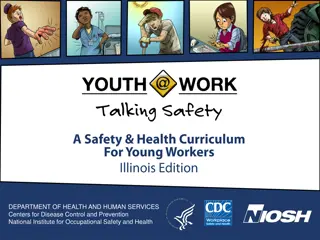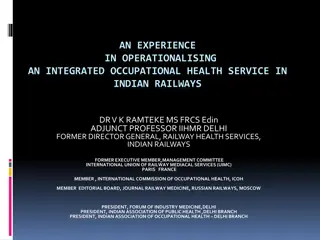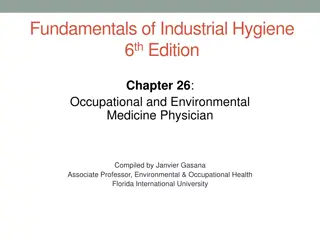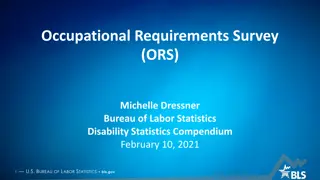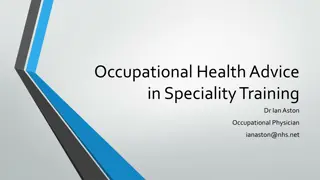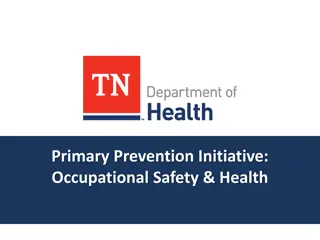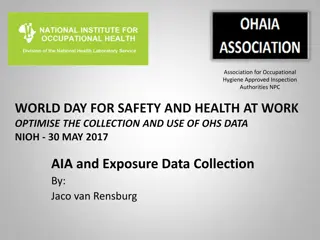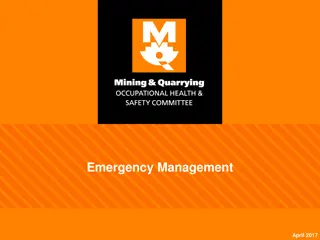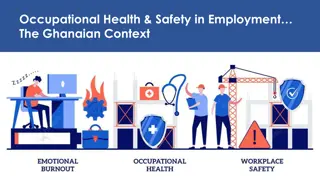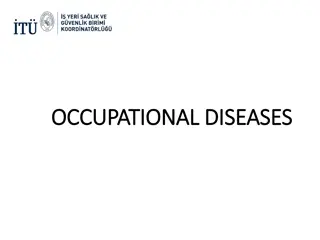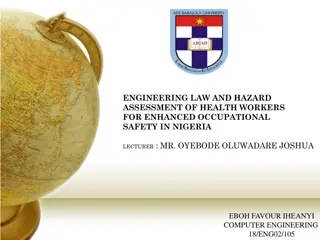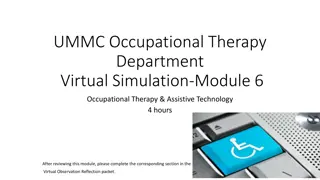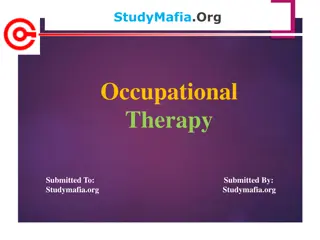Understanding Occupational Health and Safety in the Workplace
Occupational health focuses on managing health problems faced by employees in their work environment. This course explores historical development, international efforts, and the crucial role of healthcare workers in ensuring a safe workplace. General provisions for worker health and safety are discussed, emphasizing factors like cleanliness and ventilation.
- Occupational health
- Workplace safety
- Healthcare workforce
- International organizations
- Employee health
Download Presentation

Please find below an Image/Link to download the presentation.
The content on the website is provided AS IS for your information and personal use only. It may not be sold, licensed, or shared on other websites without obtaining consent from the author. Download presentation by click this link. If you encounter any issues during the download, it is possible that the publisher has removed the file from their server.
E N D
Presentation Transcript
BY NWADIKE REGINALD-FRANCIS.C 17/ENG02/052 COMPUTER ENGINEERING
INTRODUCTION Occupational health is a course that deals with the study of the health problems employees face in their work environment and how those health problems are managed to protect the health status of employee and their family. It exposes the different sources through which the employees are affected. The processes of detecting the health problems are similar to investigative processes obtainable in established health institutions.
The unit examines the historical development of occupational health; the role of health team members and the efforts of international organizations to ensure that safety measures are provided and workers get their compensation from employers. The unit looks at the historical development of OH in both developed and developing countries including Nigeria. It also looks at the contributions made by International Labour Organisation (ILO) and the World Health Organisation (WHO) in the protection of health and safety of people at work settings.
Healthcare workforce is one of the largest work forces in the world constituting over 12% of the working population in the whole world. Nigeria has one of the largest pools of healthcare personnel in Africa and they make up about one third of the total workforce in Nigeria. Health workers perform their duties in an increasing hazardous work environment and occupational settings. Personnel in this workforce are responsible for providing quality health care services, even though their work places (hospitals, clinics and laboratories) are increasingly unsafe.
General provisions for health include various regulations are available for the health, safety, and welfare of workers in each country today. However, the following factors are commonly adopted to enhance good housekeeping and the promotion and maintenance of health of the workers and include cleanliness, overcrowding, ventilation, lighting, floor drainage, and sanitary convenience. Cleanliness calls for each factory to be kept in a clean state and free from effluents
nuisance. Refuse should be removed on a daily basis, using suitable methods [15]. The floors of every work place should be washed at least once in a week. In situation of offensive trades, daily washing is required together with some other effective measures. The walls, partitions, and ceilings are washed in accordance with prescribed regulations. Repainting with oil paint or varnishing, at least once in every five years and washing at least once a year with hot water and soap or cleaned by other suitable methods.
LITERATURE REVIEW Suitable protective wears (including clothing) and appliances should be provided, maintained and its continuous use encouraged in all factories and workplace where workers are engaged in any process involving exposure to wet conditions, injuries, or offensive substances. For example, such suitable protective wear may include, where necessary, suitable gloves, effective screens, foot wears, waterproof aprons, goggles, head covers, etc.
Workers in large establishments are provided with separate rooms or canteens where their meals are prepared and served at appropriate times. Eating is prohibited at workplaces, where dangerous substances such as lead, mercury, cyanide, etc, are present. The provision of adequate running water is desirable to ensure that the workers observe personal hygiene. Efforts should be geared to educate and enlighten the workers on the rationale behind these practices.
An inspector of factory may after informing an employer or any of his agents in the workplace take for analysis samples in sufficient quantity of any substance used or intended to be used in a workplace. Particularly if the inspector thinks such a sample may prove on examination to constitute danger to the workers. A government chemist or an authorized person who may be required as a witness at a subsequent legal proceeding must analyze such sample.
Premises where offensive trades are carried out should be whitewashed or color-washed and then white or color washing should be repeated at least every year. Overcrowding regulation aims to ensure that no factories where work is being carried on should be so overcrowded as to cause risk or injury to the health of persons employed therein. To this end, each workroom must not be less than 2.75m high measured from floor to the lowest part of the ceiling or where there is no ceiling, to the lowest part of the roofing material. The cubic capacity space available for each worker must be at least 11.33 m.
This cubic air space excludes any space that may be more than 4.30 m from the floor level. Ventilation aims at ensuring continuous removal of polluted air and odor from occupied premises and the preservation of a pure dust- free atmosphere of proper temperature and humidity with sufficient movement of air. It is therefore required that all factories and workplaces should be adequately ventilated to achieve the desired effect. Open windows provide the simplest form of ventilation so long as the work place is not situated in a dusty surrounding. In order to derive maximum effect, factories should be sited to take advantage of prevailing wind where possible.
Occupational health hazards put HCWs at risk of increased morbidity and mortality. Loss of skilled health personnel will adversely affect healthcare services which are already suboptimal in developing countries such as Nigeria. The multiplying effects of occupational injuries and diseases among health workers include economic loss, physical loss and psychological disorders such as stress and depression. These have an overall negative impact on the workers, their families and the nation at large.
RECOMMENDATIONS 1. Follow established occupational safety and health procedures, avoid exposing others to health and safety risks and participate in employer-provided occupational safety and health training; 2. Use provided protocols to assess, triage and treat patients; 3. Treat patients with respect, compassion and dignity; 4. Maintain patient confidentiality; 5. Swiftly follow established public health reporting procedures of suspect and confirmed cases;
6. Provide or reinforce accurate infection prevention and control and public health information, including concerned people who have neither symptoms nor risk; 7. Put on, use, take off and dispose of personal protective equipment properly; 8. Self-monitor for signs of illness and self-isolate or report illness to managers, if it occurs; 9. Advise management if they are experiencing signs of undue stress or mental health challenges that require support interventions; and report to their immediate supervisor any situation which they have reasonable justification to believe presents an imminent and serious danger to life or health.
CONCLUSION According to the World Health Organisation (WHO), coronaviruses are a family of viruses that cause illnesses ranging from the common cold to more severe diseases such as severe acute respiratory syndrome (SARS) and the Middle East respiratory syndrome (MERS). These viruses were originally transmitted from animals to people. SARS, for instance, was transmitted from civet cats to humans while MERS moved to humans from a type of camel. Several known coronaviruses are circulating in animals that have not yet infected humans.
This study showed that majority of the government health workers had high occupational hazard risk, poor compliance to occupational safety measures despite high awareness of OHS. Clinical health workers and health workers with more than 10 years experience had better awareness of OHS.




